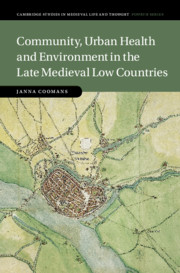Book contents
- Community, Urban Health and Environment in the Late Medieval Low Countries
- Cambridge Studies in Medieval Life and Thought Fourth Series
- Community, Urban Health and Environment in the Late Medieval Low Countries
- Copyright page
- Contents
- Figures
- Maps
- Tables
- Acknowledgements
- Note on Currency, Wages and Dates
- Abbreviations
- Introduction
- 1 Galenic Health and the Biopolitics of Flow
- 2 The Purged Urban Heart
- 3 Food, Health and the Marketplace
- 4 Good Neighbours
- 5 Plague in Urban Healthscapes
- 6 Building Community, Balancing Public Health and Order
- Conclusion Urban Health Expeditions
- Bibliography
- Index
6 - Building Community, Balancing Public Health and Order
Published online by Cambridge University Press: 17 August 2021
- Community, Urban Health and Environment in the Late Medieval Low Countries
- Cambridge Studies in Medieval Life and Thought Fourth Series
- Community, Urban Health and Environment in the Late Medieval Low Countries
- Copyright page
- Contents
- Figures
- Maps
- Tables
- Acknowledgements
- Note on Currency, Wages and Dates
- Abbreviations
- Introduction
- 1 Galenic Health and the Biopolitics of Flow
- 2 The Purged Urban Heart
- 3 Food, Health and the Marketplace
- 4 Good Neighbours
- 5 Plague in Urban Healthscapes
- 6 Building Community, Balancing Public Health and Order
- Conclusion Urban Health Expeditions
- Bibliography
- Index
Summary
delves more deeply into the role of biopolitics in community formation by studying, via criminal court records, how policy makers in practice connected or associated physical health threats to those to morality and social order. The convergence is particularly clear for three themes: poverty, leprosy and sexuality. These topics convey social groups who were each affected by a vision of a healthy, orderly and prosperous community. Policing the common good through targeting these groups was in many ways the same as performing community: it helped constituting civic conduct and moral leadership. Besides accentuating public health as a factor, the aim of this chapter is to show that the same system of reasoning and perception of community shaped attitudes toward each of these groups or issues. This reasoning was for the most part based on a medical, Galenic worldview, which is best summarised by the notion of dynamic balance. Balance can be understood as a tool in biopolitics, and it worked on two levels: the practical and the metaphorical. Analysing these two levels demonstrates how urban authorities integrated the eradication of sin as a part of their program to protect communal health.
Keywords
- Type
- Chapter
- Information
- Publisher: Cambridge University PressPrint publication year: 2021

